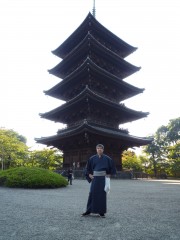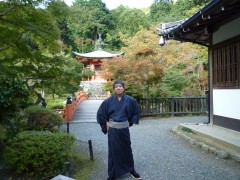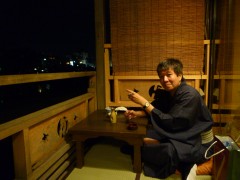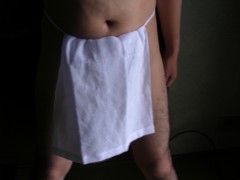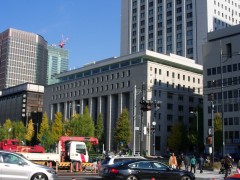09 January 2013
Why not visit Nozawa Onsen Ski and natural hot spring village?
In the beginning of this year, I went to Nozawa Onsen village in Nagano Prefecture.
The below is last year's footage, February 2012.
It is famous ski resort but it is also famous for natural hot spring town. The word, Onsen means natural hot spring in Japanese.
Interestingly enough, the town is not only famous for Japanese skiers but Australians, New Zealanders and other foreigners. A ski resort famous for foreigners I knew was Niseko in Hokkaido. I visited there two years ago. Then I learnt Australians there became more interested in Nozawa Onsen. That was why I visited Nozawa last year and this year.
The place was better than expected. Snow quality was great. The courses were varied. I saw many Australians and other foreigners skiing and snowboarding. Not as many as number I saw in Niseko but I could meet some Aussies every time I got on a lift. I even could meet them attending ski school which only provided Japanese intruction. They told me they learnt it by body language. Wow!!
I saw them outside the ski areas. That is public bath houses. There are 13 community bath houses in the village. It is open early in the morning until late at night. All of them were managed by localies and free of charge for anybody including tourists. The hot water comes from volcano line underneath the village. It smells sulfur and some of them were really hot. I could not imagine foreigners enjoying that. But I saw them quite frequently.
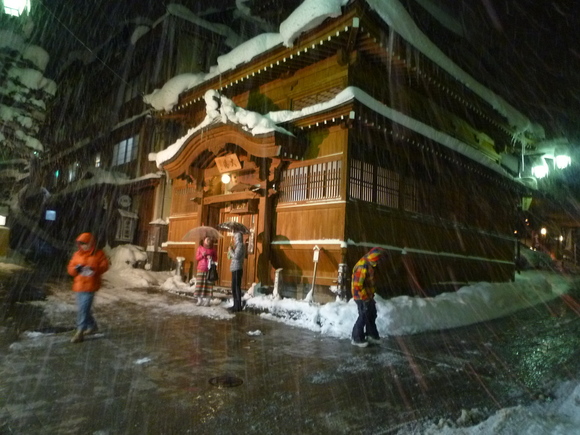
I spoke with localies. They told me they actually made sales to Australians flying there. However, they never change their village to resort style. They keep the way they have been from the past. You can't find any big hotels and leisure facilities over there. Just small local hotels, bath houses, temples, shrines, small shops, restaurants and bars. No big places except ski slopes. Very much like Japanese traditional village.
Localies seems to be proud of keeping their originality and personality. When I bathed in a community bath, one local man scolded a young boy saying "wash your penis before you get into the bath tub." That means keep the bath clean and respect the manners.
It is a very mystique place. Real winter wonderland!
17:30 Posted in Australia, Culture, Health, Japan News, Leisure, Society, Sports, Travel | Permalink | Comments (0) | Tags: ski, snow, hot spring
25 October 2012
Visited Miyako wearing Kimono
Last weekend I went to Kyoto city which was called Miyako in famous Hollywood Geisha film "Memoirs of a Geisha."
I visited there a few times in the past. But this time was kind of new experience because I wore kimono all the time during my trip.
Do you know what kimono literaly means in Japanese? It means "thing to wear." Yes, that simply means "cloth." In the old days everyone wore it in everyday life. Now people wear it occasionally only for special events such as New Year's day, coming of age or wedding ceremony. Most of us do not wear it casually. Even in Kyoto, you could rarely see people in kimono.
That should be considered very dissapointing, isn't it. That is why I decided to wear in Kyoto. Not just for special event. I did it all the time during the trip including the time I am staying at hotel and using transportation such as bus and subway. I impressed not only foreign tourists but Japanese there.
In Kyoto I visited the Geisha towns, Budhist temples and shrines. I could enjoy viewing those places in a very different way because of kimono. Kimono restrains you and makes you walk difficult. Not just kimono, I wore Japanese tradtional socks, called Tabi and sandals, called Zori. Those things disturbed me as well.
But that is why I had different experience from the past trips. I experienced how people viewed the places when the places was first established. I could share experience with people in the old eras.
Japanese lifestyle has dratiscally changed since Japan opened door to the West. We seemed lost our identity by that. Wearing kimono can revive our lost identity and traditional feeling.
See the photo of the below. That is traditional way of enjoying meals and sake. I did it on balcony of riverside restaurant. I enjoyed nice view as well as tasty sake and delicous Kyoto cuisine.
Kimono and Kyoto are what we should be proud of.
12 August 2012
Translated Novel: "Let's Fundoshi" Chapter 1
This is translation of Japanese novel on my Japanese blog site. The original title of the novel was "Nihon Danji wo Yamerarenai (Can't stop being Japanese traditionl man).
A Candadin man experiences FUNDOSHI, Japanese traditional male underwear, swimming suit and custume for festival.
Jacques Charbonneau was a Canadian man born and raised in Montreal, Quebec, Canada. He belogns to majority of that reigion, so called "French Canadian."
From his childhood, he spoke French at home. His parents and relatives were all French Canadians. But he spoke English at school. Half of his friends were Englisha dn the other half were French.
Therefore his native languages were both Englisha and French. He was a billingual but since he entered Tronto University in State of Ontario, one more language was added and then he became tringual. The third language was Japanese.
Why he studied Japanese was he met a Japanese girl named Yuriko Watanabe, whom he fell in love with. She could speak English but he wanted to speak to her directly in her mother's language. The he chose Japanese as his major. With help of Yuriko, he mastered Japanese. His Japanese was excellent so that even Yuriko said that he could speak like Japanese national. He graduated from Japanese department of the university with top rank. After graduation, he started translation and interpretation among English, French, and Japanese. Afterwards, Yuriko became an important job partner and finally a partner in his private life.
When they got married, Yuriko's father, Taizo Watanabe flew to Canada and approved their marriage. The wedding was held in a small church with attendance of small number of people. Taizo was her only family member since her mother was already dead and she was the only child for Taizo.
Jacques wanted to visit Yuriko's hometown but he had been busy for his work and he was too afraid of flying. He could not have chance to visit Japan. He always regretted that he never visited his wife's hometown. He thought he should overcome flying phobia and visit Japan. He could speak Japanese fluently but he could only use it to his wife and Japanese living in Canada.
Yuriko never recommended Jacques to visit Japan. Her hometown was one of most conservative place so localies never welcome a foreign white man like Jaques. She heard that localies did not think her marriage to a foreigner was a good thing. So They thought they did not have to regret it.
But in the third year of their marriage, the couple had to visit Japan. Taizo got sick and was hospitalized. He got out of the hospital but had to stop working and stay home for rehabilitation. A woman who lived nearby sometimes visited him to see how he was but he seemed so depressed that Yuriko should look after him to help him recover his condition.
Yuriko was so worried that the two decided to go there. Translation work could be done even after they moved to Japan as long as they could maintain internet access. They checked the IT environment there and found out there was no problem doing it.
Jacques stood for more than 10 hour flight and finally arrived in Kansai International Airport in Japan. The two travelled to her hometown, Awai Town. The town was on the coastal line of the Sea of Japan in Chugoku region, it was a fishery town. From her home, spectacular ocean view was seen from a window. Taizo gladly welcomed Yuriko and Jaques after a long absence. Taizo was a local fisherman.
They used the room Yuriko had used from her childhood. They started getting along as family. Jacques found Taizo very weak comparing what he saw at the wedding. He got thinner and looked pale. He was as tall as Yuriko but looked smaller than before. He wished he would come back his fishery work afte he regained health. He thought about how to deal with him. Jaques called hime "Otosan (Father)" like Yuriko did.
A week has passed. Things happened as expected. Localies called him "Gaijin (Foreigner)." They spoke about him behind him but they never greeted. They treated hime like outsider. He tried to understand what they said but the language they used was blended with strong accent and dialect. With Yuriko's help. Jacques gradually understood what they said.
Even after they understood the language, living in conservative and closed community was hard for him. Furthermore he was a tall white Canadian. Some stayed away just by looking at him. He was appearently discriminated.
One more troubling thing happened, that was because of season he visited.
Hot and humid climate. It was far different from where he grew up. Even Montreal could get as hot as 30 degree but such hotness was what he never experienced before. It was because of Japan's humidity.
He got sweat very soon. Japanese got used to it but Jacques never resist such wet feeling. He was adapted to the coldness but not such humidity sweating so much.
His body finally responded to it. He got eczema. It was itchy and reditsh. He could not stop scratching. What should he do? He came over to help his father in law recover but he, himself became sick.
Yuriko advised him to see a doctor. The doctor diagnosed his symptom. The result was "latex allergy" in other way, it is called "Rubber allergy."
Jacques asked a doctor "Why did I get such allergy?"
"It is because of underwear you are wearing. The rubber band got soaked and melted down to your skin. Japan's humid summer melted rubber and got into your body that caused allergy symptom. Unless you stop wearing it, it can never be cured."
"You tell me never to wear underwear? Oh, no!" Jacques was shocked to hear that. It was never comfortable living without undewear. Especially for men it was necessary to tighten private zone to stay normal.
"Since you can't wear conventional underwear, we advise patients to wear something else instead" the doctor said showing him white long cloth.
"THIS IS FUNDOSHI".
Continued to Chapter 2.
15:36 Posted in Canada, Culture, My novel, Society | Permalink | Comments (0) | Tags: japan, literature
07 December 2011
Book on US Occupation of Japan after WW2 "Washington Heights"
A book "Washington Heights" is written by a female journalist, AKIO Satoko. She studied how the United States government managed occupied Japan after the country defeated his enemy. Then she spotlighted on "Washington Heights," which was exclusive residential area for the U.S. military personnels located in the center of Tokyo. The area was built after the war was over by the order of U.S. occupational force. Before the war, it was Japanese imperial army's property. It was located next to Meiji Jingu Shrine, memorial shrine for the Meiji Emperor (crowned between 1868-1912) .
After the Olympic the place turned to famous public park, Yoyogi Park and Japan's public broadcasting station, NHK building.
The book mainly described episodes of Japan's Occupied era (1945-1952) and economic booming era until Tokyo Olympic in 1964. When the U.S. force arrived in Japan, they occupied many places in Tokyo for its administration purpose. The General Head Quarter was placed in Dai-ichi Life Insurance Building near the Imperial Palace.
But they needed housing for soldiers and staff working for the G.H.Q. So they ordered the Japanese government to build housing block for Americans, requiring facilities and equipment equivalent to American standard of that time. That was the hell of a big job for the Japanese government because the places were all burnt down, and shortage of goods.
The Washington Heights, American style housing provided Japanese new culture and lifestyle. Because American personnels and their family living there wanted entertainment, many Japanese entertainers were recruited for performances for them. That caused a big entertainment icon, Journey's Production, which has released many great talents to Japan's showbiz until now. Morie Hana, a famous Japanese fashion designer opened clothing shop for women living in the residential area. She studied most sophisticated western clothing during that time. As for food culture, Japanese learnt fresh vegetable farming to meet demands from Americans. Japanese learnt how to farm vegetable for the fresh salad taking sanitation into account.
As for how Americans thought about occupying Japan was described as well.
When Americans first arrived in Japan after the war, they were surprised because their former enemy citizens were so friendly to them. Many Japanese in fact, felt liberated when the war was over. So occupation worked more smoothly than expected. The U.S. occupation in fact provided democratization of Japan including women's suffrage, reform of biased wealth distribution towards elite class. The U.S. aim was to demilitalize Japan so they thought cracking down feudal customs and elite class power was best way to do.
The U.S. at that time were so worried about communist threat from Soviet Union. So they treated Japan nicely although Japan was a former enemy.
Most interesting episode noted in the book was that a former Japanese military officer met Afro-American man working as lower rank staff of G.H.Q. who told him that Blacks were glad when Japan attacked Pearl Harbor.
The conclusion of the book was U.S. occupation provided Japan great things but we have to remember Japan has been controlled by U.S. since that time and even after Japan recovered independence, we are always facing indirect occupation by the U.S. such as military bases in Okinawa, Tokyo, and diplomatic pressure to liberalize trade and commerce.
Recently the U.S. hegemony has been on the edge as you see "Lehman Shock" and "Occupy Wall Street" movement. The U.S. can no longer function as a role model for Japanese.
Thanks to the U.S. we could have developed the nation acquiring many great things from them but it is time we develop us ourselves in our own way.
22:01 Posted in Books, Culture, Tokyo Life, US-Japan relationship, USA issues | Permalink | Comments (0) | Tags: history, military






